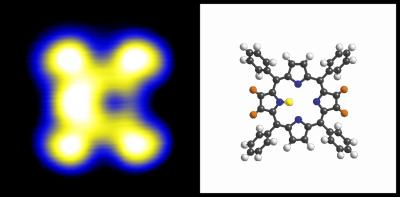In the Nature Nanotechnology journal, Technische Universitaet Muenchen (TUM) researchers have reported their unique molecular switch, which has a surface area of just one sq. nm, marking it as the smallest conceivable switch in the world.
 Physicists at the Technische Universitaet Muenchen have created a nano switch based on a single porphyrin ring. If one of two protons from the inside of the ring is removed, the remaining proton can take on any one of four positions, initiated by a single tunnel electron from the tip of a scanning tunneling microscope. (Credit: Knud Seufert / Technische Universitaet Muenchen)
Physicists at the Technische Universitaet Muenchen have created a nano switch based on a single porphyrin ring. If one of two protons from the inside of the ring is removed, the remaining proton can take on any one of four positions, initiated by a single tunnel electron from the tip of a scanning tunneling microscope. (Credit: Knud Seufert / Technische Universitaet Muenchen)
A single proton’s position within a porphyrin ring having an inner diameter of below 0.5 nm is the basis for the operation of the switch that allows setup of four different states on request. Ring-like molecules, porphyins are capable of changing their structure, enabling them suitable for numerous applications.
Tetraphenylporphyrin, a form of porphyin, assumes a saddle form, while retaining its functionality even when it is attached to a metal surface. Its molecule comprises two hydrogen atoms that can swap their locations between two patterns each. This process occurs continually at an ultrafast rate at room temperature. In the study, the TUM researchers repressed this natural process by cooling the material so as to stimulate and study the whole process in one molecule utilizing a scanning tunneling microscope, which is not only capable of determining the first and last states but also enables the researchers to directly manipulate the hydrogen atoms.
The researchers then stripped off one of the two protons present in the porphyrin ring’s inner side, which now allows the lingering proton to assume any of the four positions. A specific pattern is set in the process caused by the proton transfer initiated by the infinitesimal current that passes through the microscope’s fine tip.
The four states are totally different from one another even though the corresponding positions of the protons do not have an impact either on the bonding of the molecule with the metallic surface or its basic structure. This difference and the randomly changeable process are the basis of the switch, which can change its state up to 500 folds per second.